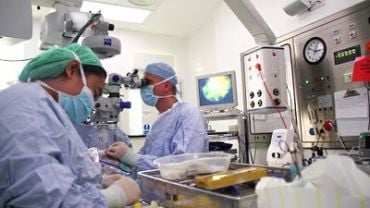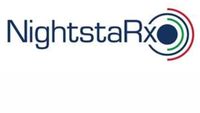
Robert MacLaren and Nightstar
Professor Robert MacLaren, from the Nuffield Laboratory of Ophthalmology in the Nuffield Department of Clinical Neurosciences, gives us an insight into his life as an entrepreneurial academic surgeon – a busy life, and one that gave rise to a gene therapy for an inherited form of progressive blindness called choroideremia. Professor MacLaren describes for us how he worked with Isis Innovation (Oxford University’s technology transfer office) to further develop this research into a therapeutic product for patients through a spin-out company, Nightstar.
This piece originally appeared in the May issue of OxfordMedSci News, the Medical Sciences newsletter.
What gets you out of bed in the morning, and why did you become an ophthalmic surgeon?
'I enjoy working with patients and giving someone their sight back is a great privilege. I find eye surgery both relaxing and creative. Even more common operations such as cataract surgery can be challenging to get right 100% of the time. Every day is different.'
When did you realise you had a great invention/technology that could help people? What was your plan at this stage?
 Professor Robert MacLaren and his team in surgery
Professor Robert MacLaren and his team in surgeryHow did it feel to get those first patient trial results?
'This was a nervous but also exciting time. I was afraid of complications as I got to know my patients well and I did not want them to lose what little sight they had if something unexpected happened. Of course I was delighted when our first patient gained 4 lines on reading the eye chart.'
Why did you first get in touch with Isis?
'Isis Innovation Technology Transfer Manager Dr Brijesh Roy helped me with the original IP, which we needed for the clinical trial funding agreement. This was back in 2009.'
Had you filed any patents, secured any translational funding or worked with Isis or another technology transfer office before?
'No, this is my first experience.'
What expertise and contacts did you find you needed to take this idea to the next stage? What did Isis bring?
'Brijesh helped me to understand the IP issues around the vector and he introduced me to the Syncona team, who were keen to fund the follow-on work for choroideremia.'
Syncona, the Wellcome Trust’s venture capital arm, invested £12 million in Nightstar: How did they find out about the technology? What was the investment process like? What were the highs and lows of this process?
 Nightstar logo
Nightstar logoHas this process helped you organise your own research and record-keeping?
'Yes, without a doubt. We have switched over to an electronic system of record-keeping with all our data in the lab. This enables us to generate information that could be submitted directly to the regulatory authorities at any stage in future. I think I now have a much better understanding of how science is viewed by the regulators who ultimately guide us along the path to getting new treatments for patients.'
How does your innovation work support your research aspirations?
'I have in my clinic hundreds of patients who are going blind but for whom we could inject a potential gene therapy cure available upstairs in our lab. The route from laboratory to clinic is long but meeting these patients every week provides a tremendous incentive for me.'
Looking back, what do you know now that you wish you’d known 5 years ago, before going through this process? What advice would you give colleagues?
'Don’t get too distracted by people who tell you that you can’t do something. Listen to the people that tell you what you can do.'
You’re a busy surgeon, you run a research group, and you’re a consultant and on the board of your spinout, Nightstar. How do you manage to prioritise?
'Not very well, but I can get through from day - to - day. Fortunately I have some expert help from three wonderful secretaries.'
What is the potential impact for patients of your work if the company is successful?
'We would have a licensed gene therapy treatment for choroideremia, but this is just the first step in a variety of retinal diseases.'
Would you like to develop other gene therapy applications commercially?
'Of course I would! This is the only way to get our exciting new laboratory discoveries into the clinic to the benefit of patients.'
